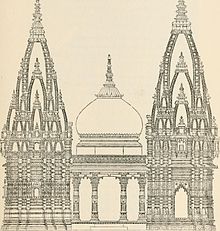History
Madhuri Desai notes that accounts of the history of the temple center around a litany of repeated destruction and reconstruction.[14] Pilgrims visiting the present Kashi Vishwanath Temple are informed about the timelessness of the lingam.[14]
Ancient and classical period[edit]
The temple is mentioned in the Puranas including the Kashi Khanda (section) of Skanda Purana (4th-5th century).
Medieval period and destruction[edit]
Main article: Razia Mosque
The original Vishwanath temple, initially known as the Adi Vishveshwara Temple, was destroyed by the Ghurids in 1194, when Mu'izz al-Din Muhammad ibn Sam returned to India and defeated Jayachandra of Kannauj near Chandawar and afterwards razed the city of Kashi.[15] In a few years[year needed], the Razia Mosque was constructed in its place.[16][17][18] In 1230, the temple was rebuilt near the Avimukteshwara Temple, away from the main site, during the reign of Delhi's Sultan Iltutmish (1211–1266). It was demolished again during the rule of either Hussain Shah Sharqi (1447–1458) or Sikandar Lodi (1489–1517).
Mughal period[edit]
Sketches by James Prinsep[19]
The Gyanvapi Mosque sketched as the Temple of Vishveshwur, Benares.
Plan of the Ancient Temple of Vishveshvur.
The dotted line shows the portion of the temple occupied by the present Masjid.
Main article: Gyanvapi Mosque
Raja Man Singh built the temple during Mughal Emperor Akbar's rule. Raja Todar Mal further rebuilt the temple in 1585, but orthodox Brahmins chose to boycott the temple because his daughter was married to Islamic rulers.[17][20] During the rule of Jahangir, Vir Singh Deo either restored or completed the construction of an earlier temple.[21] In 1669, Mughal Emperor Aurangzeb destroyed the temple and built the Gyanvapi Mosque in its place.[22] The remains of the erstwhile temple can be seen in the foundation, the columns, and at the rear part of the mosque.[23]
Maratha and British period[edit]

In 1742, the Maratha ruler Malhar Rao Holkar made a plan to demolish the mosque and reconstruct the Vishweshwar temple at the site. However, his plan did not materialise, partially because of the intervention of the Nawab of Awadh, who was given control of the territory.[24]: 2 Around 1750, the Maharaja of Jaipur commissioned a survey of the land around the site, with the objective of purchasing land to rebuild the Kashi Vishwanath temple.[24]: 85 However, his plan to rebuild the temple did not materialise either. In 1780, Malhar Rao's daughter-in-law Ahilyabai Holkar rebuilt the present temple adjacent to the mosque.
In 1828, Baiza Bai, widow of the Maratha ruler Daulat Rao Scindhia of Gwalior State, built a low-roofed colonnade with over 40 pillars in the Gyan Vapi precinct.[25] During 1833–1840, the boundary of Gyanvapi Well, the ghats and other nearby temples were constructed. Many noble families from various ancestral kingdoms of the Indian subcontinent and their prior establishments make generous contributions for the operations of the temple.
In 1835, Maharaja Ranjit Singh of the Sikh Empire, on the behest of his wife, Maharani Datar Kaur, donated 1 tonne of gold for plating the temple's dome. In 1841, Raghuji Bhonsle III of Nagpur donated silver to the temple.[24]: 200 [26]
The temple was managed by a hereditary group of pandits or mahants. After the death of Mahant Devi Dutt, a dispute arose among his successors. In 1900, his brother-in-law Pandit Visheshwar Dayal Tewari, filed a lawsuit, which resulted in him being declared the head priest.[27]
Post-Independence[edit]
The puja of the Maa Shringar Gauri Temple, on the western side of the disputed Gyanvapi Mosque, was restricted after the demolition of the Babri Masjid in December 1992 due to the ensuing deadly riots that followed the demolition of the mosque. In August 2021, five Hindu women petitioned a local court in Varanasi to be allowed to pray at the Maa Shringar Gauri Temple.[28]

In 2019, the Kashi Vishwanath Corridor Project was launched by Narendra Modi to ease access between the temple and the Ganges River, creating a wider space to prevent overcrowding. On 13 December 2021, Modi inaugurated the corridor with a sacred ceremony.[29] A press release by the government said that around 1,400 residents and businesses within the corridor's area were relocated elsewhere and compensated. It also said that more than 40 ruined, centuries-old temples were found and rebuilt, including the Gangeshwar Mahadev temple, the Manokameshwar Mahadev temple, the Jauvinayak temple, and the Shri Kumbha Mahadev temple.[30][31]
In February 2022, the sanctum sanctorum of the temple was gold-plated after an anonymous donor from South India donated 60 kg of gold to the temple.[32] Flowers from the temple are recycled into incense by the biomaterials startup Phool.co.[33]


